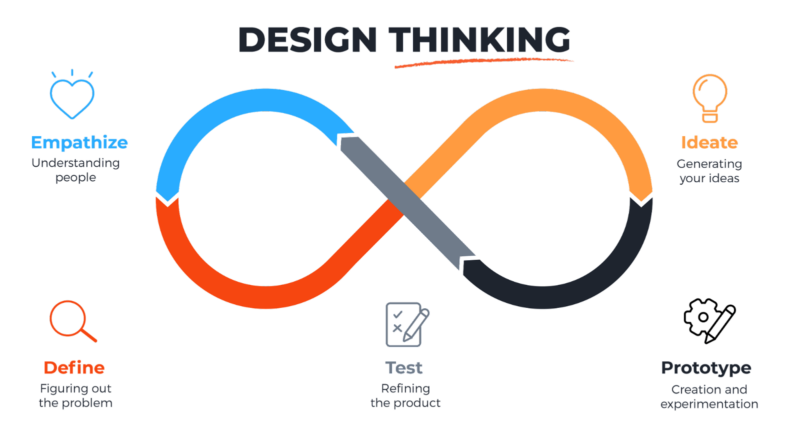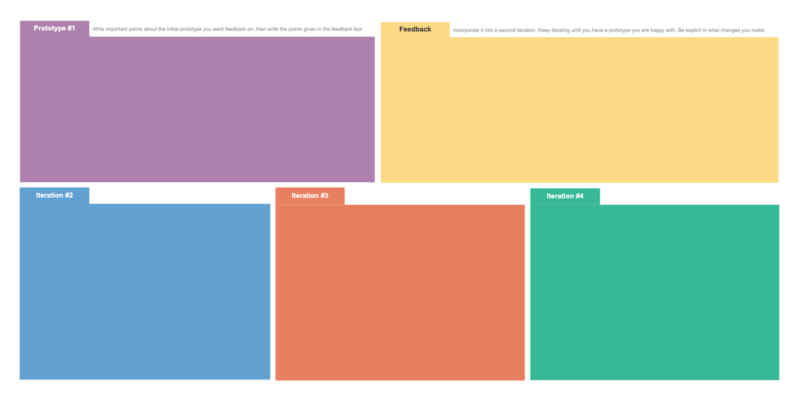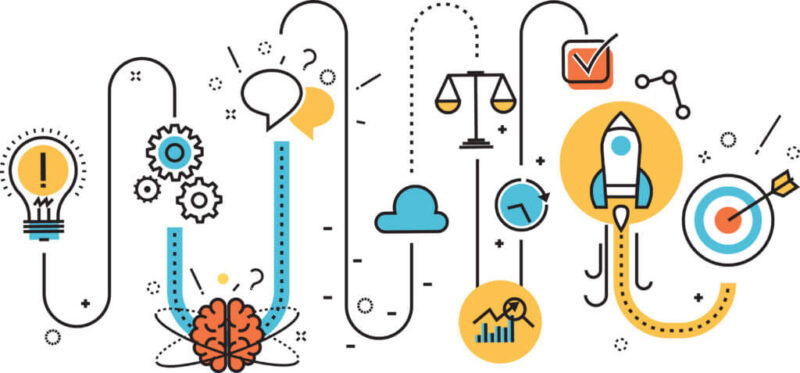Table of Contents
Design thinking is a process that has been used by institutions and businesses for years and continues to stimulate innovation and creative thinking for artists and innovators alike.
If you’re new to design thinking and want to learn more about how it works, this is the guide for you. We will begin by defining design thinking and talk about how to best apply it using online whiteboards. If you are interested in learning more about other boards, you can check out our template guides for kanbans, SWOT, and customer journey maps here.
What is Design Thinking?
Design thinking is defined as a process in which teams attempt to understand their customer, reimagine problems, and brainstorm solutions previously out of reach. By doing this, teams can creatively define new possibilities to find solutions.”
Design thinking poses a creative solution-based method of problem-solving. This allows teams to focus on the problem’s manifestations and symptoms without losing sight of the end goal.
Much of the solution-driven power of design thinking comes from an empathetic connection with the customer. The customer’s problems and needs will eventually determine the solutions that are deployed, so an empathetic connection with them is vital to the success of your design thinking process. With this in mind, let’s think about some advantages to design thinking.
Design Thinking is an iterative process that can loop back to earlier stages based on the feedback received. The goal is to refine and improve the solutions continuously, keeping the user’s perspective at the forefront of the design process. This approach is known for its flexibility and adaptability, as it can be applied to various domains, from product design and business strategy to social issues and healthcare.
Design Thinking is often associated with enhancing creativity, promoting collaboration, and fostering a user-centric mindset, making it a valuable tool for addressing complex problems and coming up with innovative solutions.
Design Thinking Principal
Design Thinking is guided by a set of principles and mindsets that help foster a user-centric, creative, and problem-solving approach. While there can be variations in the specific principles depending on the source, the following are some key principles commonly associated with Design Thinking:
- Human-Centered: This principle emphasizes that the design process should revolve around understanding and empathizing with the needs, preferences, and behaviors of the people (users or customers) for whom the solution is being designed. People are at the core of every decision and solution.
- Empathy: Empathizing with users is fundamental. This means actively seeking to understand their perspectives, feelings, and experiences. It helps designers develop a deeper understanding of the problems and needs they are addressing.
- Iterative: Design Thinking is an iterative process that involves repeated cycles of exploring, creating, and testing ideas. This allows for continuous improvement and refinement of solutions based on feedback.
- Collaborative: Collaboration is a key component of Design Thinking. It encourages cross-functional teams and diverse perspectives to foster creative thinking and problem-solving. Collaboration helps to generate a wide range of ideas and solutions.
- Mindful of Constraints: Design Thinking acknowledges and works within constraints, whether they are budgetary, technical, or resource-related. Constraints can stimulate creativity by pushing the team to find innovative solutions.
- Optimism: A positive and optimistic mindset is essential in Design Thinking. It encourages the belief that creative solutions can be found and problems can be overcome.
- Divergent and Convergent Thinking: The process involves both divergent thinking (generating a wide variety of ideas) and convergent thinking (narrowing down and selecting the best ideas). This balance is crucial for creativity and practicality.
- Prototyping: Prototyping and experimentation are central to the process. Prototypes are created to quickly visualize ideas and gather user feedback. This approach reduces the risk of investing resources in concepts that might not work.
- User Feedback: Feedback from users and stakeholders is valued and integrated into the design process. It helps identify what works and what needs improvement and ensures that the final solution is user-centric.
- Tolerance of Failure: Design Thinking embraces a culture of learning from failure. It’s understood that not all ideas will succeed, and failures are seen as opportunities for growth and improvement.
- Action-Oriented: Design Thinking emphasizes taking action and making ideas tangible. It’s not just a theoretical exercise but a practical approach to problem-solving.
- Visualization: Visualization techniques, such as sketching, diagramming, and modeling, are used to make ideas and concepts more tangible and easier to understand.
These principles help create a framework for the Design Thinking process, guiding designers and teams as they work to understand problems, generate innovative solutions, and iterate to develop user-centric and effective outcomes.
Design Thinking Process Steps for Best Practices
Are you ready to revolutionize problem-solving within your team? Our guide delves into the intricacies of the Design Thinking Process, offering not only a roadmap but a strategic approach to innovation.
Design Thinking Process Steps for Optimal Results
To establish a robust design thinking strategy, understanding each phase in the design thinking process is paramount. It’s crucial to note that these phases aren’t strictly sequential; teams might navigate them differently. Here’s an in-depth breakdown of each category:

Step 1: Empathize – Fostering Customer-Centric Solutions
Begin by infusing primary and secondary research to create profound empathy with your customers. Construct persona maps and conduct interviews to uncover real problems, steering your solutions toward authentic customer needs. Dive into why design thinking is pivotal for creative problem-solving and your business’s overall health.
Step 2: Defining Needs – Prioritizing and Organizing Ideas
Define ideas, needs, and problems through effective organization and prioritization. Explore the Moscow board as a powerful tool for prioritizing ideas, guiding the journey from defining problems to advancing the most crucial ideas. Learn how this system aids in creating guidelines for a product release, adapting seamlessly to the design thinking definition.
Step 3: Ideate – Unleashing Creative Expression
Prioritize customer problems and needs before delving into ideation. Ideation involves creative expression and brainstorming new ideas, overloaded with innovation. Incorporate visual elements to promote brainstorming, enhancing creative expression and understanding.

Step 4: Prototype – Experimentation and Visualization
In the prototyping phase, teams experiment with the implementation of their ideas, pushing boundaries and creating experimental visualizations. Discover how this step, often a tipping point, emphasizes small-scale applications to gauge real-world viability. Whether paper prototyping or small-scale implementation, this phase is the cornerstone of the brainstorming process.
Step 5: Test – Validating Solutions
Effectively put prototypes to the test in the final phase. Real decisions are made to determine if solutions are sustainable options or merely good in theory. Regardless of the steps’ order, testing serves as the crucible where ideas and prototypes either become actual implementations or prompt iterative refinement.
The Art of Design Thinking: A Non-Linear, Iterative Process
Design thinking is an iterative, non-linear process fostering collaboration between designers and users. Explore the five core stages – Empathize, Define, Ideate, Prototype, and Test – not as strict sequences but as modes contributing to the entire design project. Understand why this non-linear approach creates a perpetual loop, offering new insights and a profound understanding of real users and the problems they face.
Optimize your problem-solving journey with our in-depth guide to the dynamic and transformative world of Design Thinking.
Learn more: Design Thinking Exercises for Virtual Workshops
Design Thinking Advantages
There are many applications to using design-based thinking that apply outside of typical artistic fields. These advantages often arise because design thinking breaks a common brainstorming pattern called ingrained thinking.
Ingrained thinking occurs when people develop patterns of thought based on their routine and familiar situations. These patterns of thought help the brain in everyday life but end up narrowing our ability to creatively find new solutions that exist outside of our traditional thought schema.
Design thinking is a strategy that helps brainstorm solutions outside of that bubble and pushes people to ideate in places that they might not traditionally find. Being able to apply a fresh mind to a new set of problems is much more likely to find new and innovative solutions, which is one reason that design thinking is heavily used in team brainstorming. These are some of the reasons to emphasize design thinking, and here are a couple of distinct advantages.

1. Allows for new perspectives/creative solutions
The core advantage of design thinking is to build new perspectives and solutions from a place they were not previously accessible. This is enabled by the creative and visual method of ideation, which is inherently different than other brainstorming and problem-solving strategies.
By grouping fresh minds and asking them to visualize the user-identified problems, you will promote innovative solutions that would not have been easily reached before. This is a capability that is inherent to this train of thought, making this strategy a huge advantage to teams that brainstorm with regularity.
2. Addresses Root Problems
Design thinking exercises are geared toward creating sustainable and lasting solutions. To create sustainable solutions, they have to address the root causes of the problems at hand.
As we will discuss later, there are many different phases to the design process and some of the first steps involve interviewing users and researching the problems they experience. This step is often overlooked in simple brainstorming exercises and is critical to establishing solutions that properly target the customer’s needs. By doing first-hand research and taking time to understand the problems and needs of the customer, design thinking guarantees an informed and scalable solution that will sustainably meet the needs of your customer.
3. Expands the entire team’s knowledge
Design thinking is a process that works to expand the knowledge of everyone involved. It hinges on the team working together to think outside of the box and develop solutions outside of their previous experiences.
Just like other brainstorming activities, bringing people together to ideate allows them to transfer knowledge between them, effectively doubling their intellectual capital. This collaboration makes design thinking incredibly effective and exposes everyone involved to new and innovative ideas. Being able to not only visualize the products of someone else’s brainstorming but also see how their thought process evolves can also stem innovation in teams working on design thinking exercises.
Learn more: What is Visual Thinking?
Conclusion
Design thinking is a problem-solving process that is gaining popularity, so hopefully, this guide has been helpful in understanding its phases and definition. If you are interested in learning more about online whiteboards or virtual workshops, you can check out our comprehensive guides by clicking the links, and you can also take a look at our recent blog post about online whiteboards on the Ideascale blog.
Most Recent Posts
Explore the latest innovation insights and trends with our recent blog posts.













